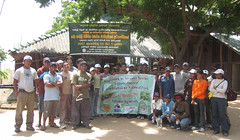
Udawalawa invasive plant eradication group
Originally uploaded by Hiran Amarasekera
Assignments, seminar abstracts and research abstracts by B.Sc. and M.Sc. students of Department of Forestry and Environment Science, University of Sri Jayewardenepura, Sri Lanka.
PROTECTED AREA AND WILD LIFE MANAGEMENT PROJECT OF DEPARTMENT OF WILD LIFE CONSERVATION, SRI LANKA
GAYATHRI S. ABHAYARATHNE
Sri Lanka is considered as the highest biodiverse country per unit area in Asia. The protected areas (PA’s) in Sri Lanka include some of the most species rich and endemic rich eco systems. Hence the threat to these PA’s and its wild life is much more increased due to reasons as encroachment and poaching of wild life, higher grazing of livestock, illegal gem mining, collection of non wood forest products ect. Due to these reasons a proper management of these PA’s should be enhanced. Hence this project is implemented in Sri Lanka to protect our PA’s and their wild life along with improving the living standards of community living in the buffer zones and stimulating eco-tourism industry in Sri Lanka.
This project consisting of four components as Enhancing Institutional Capacity for protected Area Management, Participatory Adaptive Management of selected Protected Areas, Collaborative Conservation Planning, Sustainable Financing for Community Partnership Building. With the consideration of biodiversity and the ecological value and to represent the different climatic zones seven PA’s were selected as pilot areas to implement this project. They are Wasgomuwa, Bundala, Peak wilderness, Minneriya, Horton Plains, Ritigala and Udawalawa. The project is funded by the Asian development bank, Global environmental facility, Government of Netherlands, Government of Sri Lanka and it is implemented in 17th October 2001. Although it has been scheduled to complete in December 2006 due to different reasons, the project is given an extension time period to be completed in end of 2008.
The first component of the project is mainly focused on enhancing the capacity of Department of Wild Life conservation for the proper PA management and component B is focused on developing infra structure facilities for both the animals as well as eco-tourists. Completing the Bio Diversity Action Plan and continuous updating of the red list is considered in the component C while component D is mainly targeted on establishing a fund to carry on the community based activities.
When considering about the progress of activities up to first quarter of 2006, the establishment of boundary demarcations, live fencing and fire line establishment are in progress. Completions of park buildings in many PA’s have been completed while others are in progress.
Scarcities of construction materials, unskilled labors, poor cash flow and suspension of construction of DWLC head office have been adversely affected for the improper implementation of the project.
At the end of the project, it will provide a protected area network in Sri Lanka while conserving its wild life resources. Not only the DWLC can protect and observe these PA’s, if all relevant stakeholders as well as the community involved for implementing this protection and conservation aspect, this can be implemented to all the PA’s in Sri Lanka.